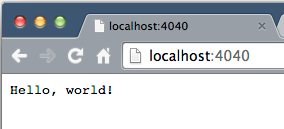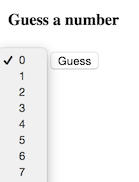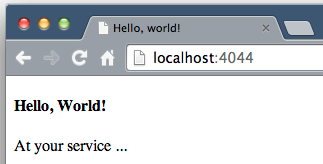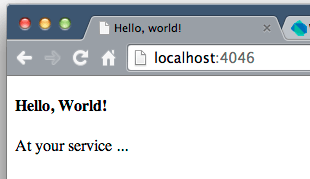- Get the source code
- Run the hello world server
- Binding a server to a host and port
- Using HTML forms to make GET requests
- Listening for and handling requests
- Making a POST request from a standalone client
- Handling a POST request in a server
- Using the http_server package
- Using https with bindSecure()
- Other resources
- What next?
What's the point?
- The HTTP protocol allows clients and servers to communicate.
- The dart:io package has classes for writing HTTP programs.
- Servers listen for requests on a host and port.
- Clients send requests using an HTTP method request.
- The http_server package provides higher-level building blocks.
HTTP (Hypertext Transfer Protocol) is a communication protocol used to send data from one program to another over the internet. At one end of the data transfer is a server and at the other end is a client. The client is often browser-based (either a user typing in a browser or a script running in a browser), but might also be a standalone program.
The server binds to a host and port (it makes an exclusive connection to an IP address and a port number). Then the server listens for requests. Because of Dart’s asynchronous nature, the server can handle many requests at a single time, as follows:
- Server listens
- Client connects
- Server accepts and receives request (and continues to listen)
- Server can continue to accept other requests
- Server writes response of request or several, possibly interleaved, requests
- Server finally ends (closes) the response(s).
In Dart, the dart:io library contains the classes and functions you need to write HTTP clients and servers. In addition, the http_server package contains some higher-level classes that make it easier to write clients and servers.
This tutorial provides several examples that show how easy it is to write Dart HTTP servers and clients. Beginning with the hello world of servers, you learn how to write the code for a server from binding and listening to responding to requests. You also learn about the client side: making different kinds of requests (GET and POST), writing browser-based and command-line clients.
Get the source code
- Get the Dart Tutorials example code.
- View the
httpserverdirectory, which contains the sources you need for this tutorial.
Run the hello world server
Example file for this section: hello_world_server.dart.
Let’s begin with a small server that responds to all requests
with the string Hello, world!
At the command line, run the hello_world_server.dart script:
$ cd httpserver
$ dart run bin/hello_world_server.dart
listening on localhost, port 4040
open_in_browser
In any browser, visit localhost:4040.
The browser displays Hello, world!

In this case, the server is a Dart program and the client is the browser you used. However, you can write client programs in Dart—either a browser-based client script, or a standalone program.
A quick glance at the code
In the code for the hello world server, an HTTP server binds to a host and port, listens for HTTP requests, and writes a response. Note that the program imports the dart:io library, which contains the HTTP-related classes both for server-side programs and for client-side programs (but not for web apps).
import 'dart:io';
Future main() async {
var server = await HttpServer.bind(
InternetAddress.loopbackIPv4,
4040,
);
print('Listening on localhost:${server.port}');
await for (HttpRequest request in server) {
request.response.write('Hello, world!');
await request.response.close();
}
}The next few sections cover server-side binding, making a client-side GET request, listening, and responding.
Binding a server to a host and port
Example for this section: hello_world_server.dart.
The first statement in main() uses HttpServer.bind() to create an
HttpServer object and bind it to a host and port.
var server = await HttpServer.bind(
InternetAddress.loopbackIPv4,
4040,
);The code uses await to call the bind method asynchronously.
Hostname
The first parameter of bind() specifies the hostname.
You can specify a particular hostname or IP address as a String.
Alternatively, you can specify the host using these predefined values
provided by the InternetAddress class:
| Value | Use case |
|---|---|
| loopbackIPv4 or loopbackIPv6 |
The server listens for client activity on the loopback address, which is effectively localhost. Uses either version 4 or 6 of the IP protocol. These are used primarily for testing. We recommend that you use these values instead of localhost or 127.0.0.1. |
| anyIPv4 or anyIPv6 |
The server listens for client activity on the specified port on any IP address. Uses either version 4 or 6 of the IP protocol. |
By default, when using a V6 internet address, a V4 listener is used as well.
Port
The second parameter to bind() is an integer
that specifies the port.
The port uniquely identifies a service on the host computer.
Port numbers below 1024 are reserved (except for 0)
for standard services.
For example, FTP data transfer typically runs on port 20,
quote of the day on port 17, and HTTP on port 80.
Your program should use port numbers from 1024 and higher.
If the port is already in use,
the connection for your server will be refused.
Listening for requests
The server begins listening for HTTP requests using await for.
For each request received, the code sends a “Hello, world!” response.
await for (HttpRequest request in server) {
request.response.write('Hello, world!');
await request.response.close();
}You’ll learn more about what the HttpRequest object contains and how to write the response in the section Listening for and handling requests. But first, let’s look at one way a client generates a request.
Using HTML forms to make GET requests
Example files for this section: number_thinker.dart and make_a_guess.html.
This section features a command-line server that
randomly chooses a number between 0 and 9.
The client is a basic HTML web-page, make_a_guess.html,
that you can use to guess the number.
Try it!
-
Run the number thinker server
At the command line, run the
number_thinker.dartserver. You should see something similar to the following:$ cd httpserver $ dart run bin/number_thinker.dart I'm thinking of a number: 6 -
Launch the web server
Run
webdev servefrom the top directory of the app.More information: webdev documentation
-
Open the HTML page
In a browser, go to localhost:8080/make_a_guess.html.
-
Make a guess
Choose a number and press the Guess button.

No Dart code is involved in the client. The client request is made from the browser to the Dart server through an HTML form within make_a_guess.html, which provides an automatic way to formulate and send client HTTP requests. The form contains the pull-down list and the button. The form also specifies the URL, which includes the port number, and the kind of request (the request method). It might also include elements that build a query string.
Here’s the form HTML from make_a_guess.html:
<form action="http://localhost:4041" method="GET">
<select name="q">
<option value="0">0</option>
<option value="1">1</option>
<option value="2">2</option>
<!-- ··· -->
<option value="9">9</option>
</select>
<input type="submit" value="Guess">
</form>Here’s how the form works:
- The form’s
actionattribute is assigned the URL to send the request to. - The form’s
methodattribute defines the kind of request, here aGET. Other common kinds of request include POST, PUT, and DELETE. - Any element within the form that has a
name, like the<select>element, becomes a parameter in the query string. - When pressed, the submit button (
<input type="submit"...>) formulates the request based on the content of the form and sends it.
A RESTful GET request
REST (REpresentational State Transfer) is a set of principles for designing Web services. Well-behaved HTTP clients and servers observe the REST principles defined for GET requests.
A GET request:
- only retrieves data
- doesn’t change the state of the server
- has length limits
- can send query strings in the URL of the request
The client in this example makes a REST-compliant GET request.
Listening for and handling requests
Example files for this section: number_thinker.dart and make_a_guess.html.
Now that you’ve seen the browser-based client for this example,
let’s take a look at the Dart code for the number thinker server,
starting with main().
Once again the server binds to a host and port.
Here, the top-level handleRequest() method is called for each
request received. Because HttpServer implements Stream,
you can use await for to process the requests.
import 'dart:io';
import 'dart:math' show Random;
Random intGenerator = Random();
int myNumber = intGenerator.nextInt(10);
Future main() async {
print("I'm thinking of a number: $myNumber");
HttpServer server = await HttpServer.bind(
InternetAddress.loopbackIPv4,
4041,
);
await for (var request in server) {
handleRequest(request);
}
}When a GET request arrives, the handleRequest() method calls
handleGet() to process the request.
void handleRequest(HttpRequest request) {
try {
if (request.method == 'GET') {
handleGet(request);
} else {
// ···
}
} catch (e) {
print('Exception in handleRequest: $e');
}
print('Request handled.');
}An HttpRequest object has many properties that provide information about the request. The following table lists some useful properties:
| Property | Information |
|---|---|
method |
One of 'GET', 'POST', 'PUT', and so on. |
uri |
A Uri object: scheme, host, port, query string, and other information about the requested resource. |
response |
An HttpResponse object: where the server writes its response. |
headers |
An HttpHeaders object: the headers for the request, including ContentType, content length, date, and so on. |
Using the method property
The code below from the number thinker example uses the HttpRequest method
property to determine what kind of request has been received.
This server handles only GET requests.
if (request.method == 'GET') {
handleGet(request);
} else {
request.response
..statusCode = HttpStatus.methodNotAllowed
..write('Unsupported request: ${request.method}.')
..close();
}Using the uri property
Typing a URL into a browser generates a GET request, which simply requests data from the specified resource. It can send a minimal amount of data along with the request through a query string attached to the URI.
void handleGet(HttpRequest request) {
final guess = request.uri.queryParameters['q'];
// ···
}Use the uri property from the HttpRequest object to get a Uri object
that contains the information about the URL typed by the user.
The queryParameters property of the Uri object is a Map containing
the components of the query string.
Refer to the desired parameter by name.
This example uses q to identify the guessed number.
Setting the status code for the response
The server should set the status code to indicate the success or
failure of the request. Earlier you saw the number thinker set
the status code to methodNotAllowed to reject non-GET requests.
Later in the code,
to indicate that the request was successful and the response is complete,
the number thinker server sets the HttpResponse status code to HttpStatus.ok.
void handleGet(HttpRequest request) {
final guess = request.uri.queryParameters['q'];
final response = request.response;
response.statusCode = HttpStatus.ok;
// ···
}HttpStatus.ok and HttpStatus.methodNotAllowed are
two of many predefined status codes in the HttpStatus class.
Another useful predefined status code is
HttpStatus.notFound (your classic 404).
In addition to statusCode,
the HttpResponse object has other useful properties:
| Property | Information |
|---|---|
contentLength |
The length of the response; -1 means the length is not known in advance. |
cookies |
A List of Cookies to set in the client. |
encoding |
The Encoding used when writing strings, like JSON and UTF-8. |
headers |
The response headers, an HttpHeaders object. |
Writing the response to the HttpResponse object
Every HttpRequest object has a corresponding HttpResponse object. The server sends data back to the client through the response object.
Use one of the HttpResponse write methods
(write(), writeln(), writeAll(), or writeCharCodes())
to write the response data to the HttpResponse object.
Or connect the HttpResponse object to a stream via addStream
and write to the stream.
Close the object when the response is complete.
Closing the HttpResponse object
sends the data back to the client.
void handleGet(HttpRequest request) {
// ···
if (guess == myNumber.toString()) {
response
..writeln('true')
..writeln("I'm thinking of another number.")
..close();
// ···
}
}Making a POST request from a standalone client
Example files for this section: basic_writer_server.dart and basic_writer_client.dart.
In the hello world and number thinker examples, the browser generated simple GET requests. For more complex GET requests and other kinds of requests, such as POST, PUT, or DELETE, you need to write a client program, of which there are two kinds:
-
A standalone client program, which uses the HttpClient class from
dart:io. -
A browser-based client, which uses API from dart:html. This tutorial does not cover browser-based clients. To look at code for a browser-based client and related server, see note_client.dart, note_server.dart, and note_taker.html.
Let’s look at a standalone client,
basic_writer_client.dart, and its serverbasic_writer_server.dart. The client makes a POST request to save JSON data to a server-side file. The server accepts the request and saves the file.
Try it!
Run the server and client on the command line.
-
First, run the server:
$ cd httpserver $ dart run bin/basic_writer_server.dart -
In a new terminal, run the client:
$ cd httpserver $ dart run bin/basic_writer_client.dart Wrote data for Han Solo.
Look at the JSON data that the server wrote to file.txt:
{"name":"Han Solo","job":"reluctant hero","BFF":"Chewbacca","ship":"Millennium Falcon","weakness":"smuggling debts"}
The client creates an HttpClient object and uses the
post() method to make the request.
Making a request involves two Futures:
-
The
post()method establishes a network connection to the server and returns the first Future, which completes with an HttpClientRequest object. -
The client composes the request object and closes it. The
close()method sends the request to the server and returns the second Future, which completes with an HttpClientResponse object.
import 'dart:io';
import 'dart:convert';
String _host = InternetAddress.loopbackIPv4.host;
String path = 'file.txt';
Map jsonData = {
'name': 'Han Solo',
'job': 'reluctant hero',
'BFF': 'Chewbacca',
'ship': 'Millennium Falcon',
'weakness': 'smuggling debts'
};
Future main() async {
HttpClientRequest request = await HttpClient().post(_host, 4049, path) /*1*/
..headers.contentType = ContentType.json /*2*/
..write(jsonEncode(jsonData)); /*3*/
HttpClientResponse response = await request.close(); /*4*/
await utf8.decoder.bind(response /*5*/).forEach(print);
}-
The
post()method requires the host, port, and the path to the requested resource. In addition topost(), the HttpClient class provides functions for making other kinds of requests, includingpostUrl(),get(), andopen(). -
An HttpClientRequest object has an HttpHeaders object, which contains the request headers. For some headers, like
contentType, HttpHeaders has a property specific to that header. For other headers, use theset()method to put the header in the HttpHeaders object. -
The client writes data to the request object using
write(). The encoding, JSON in this example, matches the type specified in the ContentType header. -
The
close()method sends the request to the server and, when complete, returns an HttpClientResponse object. -
The UTF-8 response from the server is decoded. Use a transformer defined in the dart:convert library to convert the data into regular Dart string format.
A RESTful POST request
Similar to GET requests, REST provides guidelines for POST requests.
A POST request:
- creates a resource (in this example, a file)
- uses a URI that has a structure similiar to file and directory pathnames; for example, the URI has no query string
- transfers data as JSON or XML
- has no state and does not change the state of the server
- has no length limits
The client in this example makes REST-compliant POST requests.
To see client code that makes REST-compliant GET requests, look at number_guesser.dart. It’s a standalone client for the number thinker server that makes periodic guesses until it guesses correctly.
Handling a POST request in a server
Example files for this section: basic_writer_server.dart and basic_writer_client.dart.
An HttpRequest object is a stream of byte lists (Stream<List<int>>).
To get the data sent from the client,
listen for data on the HttpRequest object.
If the request from the client contains a large amount of data, the data might arrive in multiple chunks. You can use the join() method in Stream to concatenate the string values of those chunks.

The basic_writer_server.dart file implements
a server that follows this pattern.
import 'dart:io';
import 'dart:convert';
String _host = InternetAddress.loopbackIPv4.host;
Future main() async {
var server = await HttpServer.bind(_host, 4049);
await for (var req in server) {
ContentType contentType = req.headers.contentType;
HttpResponse response = req.response;
if (req.method == 'POST' &&
contentType?.mimeType == 'application/json' /*1*/) {
try {
String content =
await utf8.decoder.bind(req).join(); /*2*/
var data = jsonDecode(content) as Map; /*3*/
var fileName = req.uri.pathSegments.last; /*4*/
await File(fileName)
.writeAsString(content, mode: FileMode.write);
req.response
..statusCode = HttpStatus.ok
..write('Wrote data for ${data['name']}.');
} catch (e) {
response
..statusCode = HttpStatus.internalServerError
..write('Exception during file I/O: $e.');
}
} else {
response
..statusCode = HttpStatus.methodNotAllowed
..write('Unsupported request: ${req.method}.');
}
await response.close();
}
}-
The request has an HttpHeaders object. Recall that the client set the
contentTypeheader to JSON (application/json). This server rejects requests that are not JSON-encoded. -
A POST request has no limit on the amount of data it can send and the data might be sent in multiple chunks. Furthermore, JSON is UTF-8, and UTF-8 characters can be encoded over multiple bytes. The join() method puts the chunks together.
-
The data sent by the client is JSON formatted. The server decodes it using the JSON codec available in the dart:convert library.
-
The URL for the request is localhost:4049/file.txt. The code
req.uri.pathSegments.lastextracts the file name from the URI:file.txt.
A note about CORS headers
If you want to serve clients that are running on a different origin (a different host or port), you need to add CORS headers. The following code, take from note_server.dart, allows POST and OPTIONS requests from any origin. Use CORS headers with caution, because they can open your network up to security risks.
void addCorsHeaders(HttpResponse response) {
response.headers.add('Access-Control-Allow-Origin', '*');
response.headers
.add('Access-Control-Allow-Methods', 'POST, OPTIONS');
response.headers.add('Access-Control-Allow-Headers',
'Origin, X-Requested-With, Content-Type, Accept');
}For more information, refer to Wikipedia’s article Cross-origin resource sharing.
Using the http_server package
Example files for this section: mini_file_server.dart and static_file_server.dart.
For some higher-level building blocks,
we recommend that you try the
http_server
pub package,
which contains a set of classes that,
together with the HttpServer class in the dart:io library,
make it easier to implement HTTP servers.
In this section, we compare a server written using API only from dart:io to a server with the same functionality written using dart:io together with http_server.
You can find the first server in mini_file_server.dart.
It responds to all requests by returning the contents of the
index.html file from the web directory.
Try it!
-
Run the server on the command line:
$ cd httpserver $ dart run bin/mini_file_server.dart -
Type localhost:4044 into the browser. The server displays an HTML file:

Here’s the code for mini file server:
import 'dart:io';
File targetFile = File('web/index.html');
Future main() async {
Stream<HttpRequest> server;
try {
server = await HttpServer.bind(InternetAddress.loopbackIPv4, 4044);
} catch (e) {
print("Couldn't bind to port 4044: $e");
exit(-1);
}
await for (HttpRequest req in server) {
if (await targetFile.exists()) {
print("Serving ${targetFile.path}.");
req.response.headers.contentType = ContentType.html;
try {
await req.response.addStream(targetFile.openRead());
} catch (e) {
print("Couldn't read file: $e");
exit(-1);
}
} else {
print("Can't open ${targetFile.path}.");
req.response.statusCode = HttpStatus.notFound;
}
await req.response.close();
}
}This code determines whether the file exists, and if it does, opens the file and pipes the contents to the HttpResponse object.
The second server, whose code you can find in basic_file_server.dart, uses the http_server package.
Try it!
-
Run the server on the command line:
$ cd httpserver $ dart run bin/basic_file_server.dart -
Type localhost:4046 into the browser. The server displays the same index.html file as the previous:

In this server, the code for handling the request is much shorter, because the VirtualDirectory class handles the details of serving the file.
import 'dart:io';
import 'package:http_server/http_server.dart';
File targetFile = File('web/index.html');
Future main() async {
VirtualDirectory staticFiles = VirtualDirectory('.');
var serverRequests =
await HttpServer.bind(InternetAddress.loopbackIPv4, 4046);
await for (var request in serverRequests) {
staticFiles.serveFile(targetFile, request);
}
}Here, the requested resource, index.html, is served by
the serveFile() method in the VirtualDirectory class.
You don’t need to write code to open a file and pipe its contents
to the request.
Another file server, static_file_server.dart,
also uses the http_server package.
This server serves any file from the server’s directory
or subdirectory.
Run static_file_server.dart, and test it with the URL
localhost:4048.
Here is the code for static_file_server.dart.
import 'dart:io';
import 'package:http_server/http_server.dart';
Future main() async {
var staticFiles = VirtualDirectory('web');
staticFiles.allowDirectoryListing = true; /*1*/
staticFiles.directoryHandler = (dir, request) /*2*/ {
var indexUri = Uri.file(dir.path).resolve('index.html');
staticFiles.serveFile(File(indexUri.toFilePath()), request); /*3*/
};
var server = await HttpServer.bind(InternetAddress.loopbackIPv4, 4048);
print('Listening on port 4048');
await server.forEach(staticFiles.serveRequest); /*4*/
}-
Allows clients to request files within the server’s directory.
-
An anonymous function that handles requests for the directory itself, that is, the URL contains no filename. The function redirects these requests to
index.html. -
The
serveFilemethod serves a file. In this example, it servesindex.htmlfor directory requests. -
The
serveRequestmethod provided by the VirtualDirectory class handles requests that specify a file.
Using https with bindSecure()
Example for this section: hello_world_server_secure.dart.
You might have noticed that the HttpServer class defines a
method called bindSecure(), which provides a secure connection
using HTTPS (Hyper Text Transfer Protocol with Secure Sockets Layer).
To use the bindSecure() method, you need a certificate,
which is provided by a Certificate Authority (CA).
For more information about certificates refer to
What is SSL and what are Certificates?
For illustrative purposes only,
the following server, hello_world_server_secure.dart,
calls bindSecure() using
a certificate created by the Dart team for testing.
You must provide your own certificates for your servers.
import 'dart:io';
String certificateChain = 'server_chain.pem';
String serverKey = 'server_key.pem';
Future main() async {
var serverContext = SecurityContext(); /*1*/
serverContext.useCertificateChain(certificateChain); /*2*/
serverContext.usePrivateKey(serverKey, password: 'dartdart'); /*3*/
var server = await HttpServer.bindSecure(
'localhost',
4047,
serverContext, /*4*/
);
print('Listening on localhost:${server.port}');
await for (HttpRequest request in server) {
request.response.write('Hello, world!');
await request.response.close();
}
}-
Optional settings for a secure network connection are specified in a SecurityContext object. There is a default object, SecurityContext.defaultContext, that includes trusted root certificates for well-known certificate authorities.
-
A file containing the chain of certificates from the server certificate up to the root of the signing authority, in PEM format.
-
A file containing the (encrypted) server certificate private key, in PEM format.
-
The context argument is required on servers, optional for clients. If it is omitted, then the default context with built-in trusted roots is used.
Other resources
Visit these API docs for further details about the classes and libraries discussed in this tutorial.
| Dart class | Purpose |
|---|---|
| HttpServer | An HTTP server |
| HttpClient | An HTTP client |
| HttpRequest | A server-side request object |
| HttpResponse | A server-side response object |
| HttpClientRequest | A client-side request object |
| HttpClientResponse | A client-side response object |
| HttpHeaders | The headers for a request |
| HttpStatus | The status of the response |
| InternetAddress | An internet address |
| SecurityContext | Contains certificates, keys, and trust information for a secure connection |
| http_server package | A package with higher-level HTTP classes |
What next?
- If you haven’t yet tried the server-side codelab, try writing a server app.
- Servers with Dart links to resources for writing standalone Dart applications, including servers.